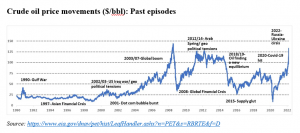
We could expect a 15-basis point hike in reverse repo rate in the April 6 RBI monetary policy committee meeting. The RBI will effect 100 basis point increase in policy rates in the current financial year and further 50 basis point hike in 2023-24.
Crude oil prices averaged $115 a barrel, so inflation will average around 5.5%, compared with the earlier forecast of 4.75%. There are limits to a low reverse repo rate of 3.35%. It is alright to run negative interest rates in a crisis, but prolonged low rates lead to a rise in inflation as evident from history. For example, in 2004, 2005 and 2006, the RBI acted fast and raised policy rates to 4.5%. This helped the economy notch up reasonable growth rates. In 2010, the RBI delayed increasing policy rates that had an adverse impact on economic growth.
The US Federal Reserve is set to hike policy rates again due to high inflation. Sticky inflation of this order does not come down easily. Rising inflation in India was thought to be a supply side shock. However, it is now understood by experts as a demand side problem. If inflation is allowed to rise to such high levels it is not easy to bring it down without monetary tightening, leading to a recession.
READ I Inflation vs growth: RBI set to end to monetary easing cycle
RBI must address inflation asap
Ideally, the RBI should raise policy rates by another 175 basis points in 2022-23 to address the uncertainty from the rise in commodity prices and crude oil prices triggered by the Russia-Ukraine war. The country’s forex reserves position is strong and this will protect the rupee from depreciation. There is a limit to waiting as the Federal Reserve will hike rates by 200 basis points.
The differential in Indian-US policy rates is 300 basis points which is below historical levels. If the RBI keeps on waiting like in 2005, it will have to undertake swift and rapid hikes. In 2005, there was an advantage of high economic growth, but in the current period there is a slow recovery. It is important to start gradually hiking the policy rates as going it later in haste would destabilise the economic system. The RBI should gradually hike policy rates starting now.
The fiscal deficit is high, there is a gap of Rs 4-5 trillion in the bond market. There is less market demand for bonds hence the government cannot borrow. The foreign exchange reserves are high at $670 billion. Hence, if RBI sells forex, it will create room for open market operations (OMO). The reserve money requirement is $56 billion in FY23.
READ I Lessons from Ukraine: India must launch digital rupee to compete with the yuan

If crude oil prices stay at a certain level, then the government will have to cut taxes to prevent further rises in inflation, thereby sacrificing its own revenues. If the oil prices are at $115 a barrel, the current account deficit is at 3.5% of the GDP. If the RBI loads about $20 billion of outflows, the CENTRAL BANK would have to sell $70 billion of foreign exchange. If the RBI is going to use $56 billion of reserve money, then in theory RBI can do open market operations of $126 billion.
The bond market is prepared for a policy rate hike hence there will be no adverse effects on the bond market. The current yield of the bond market is 7% and if policy rates are hiked then the yield will be 7.5%. The current period is a period of shallow recovery. The base case growth of GDP is estimated to be 7.4% for FY23 and there could be some downside risks to this by raising policy rates. History shows that if policy rates are hiked gradually then there is greater economic growth while delaying and then rapidly raising rates can impair economic growth.
(Indranil Sen Gupta is head of India Research, CLSA. This article is a reproduction of his presentation at EGROW Foundation’s shadow MPC meeting held on April 1.)
